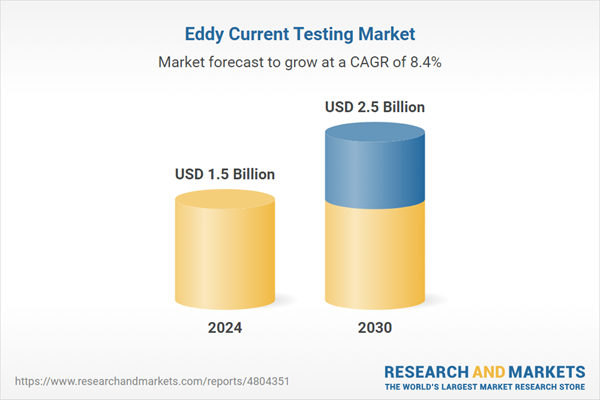Global Eddy Current Testing Market - Key Trends and Drivers Summarized
What Exactly Is Eddy Current Testing and Why Is It Essential?
Eddy Current Testing (ECT) stands out as a crucial technique in the realm of Non-Destructive Testing (NDT), where its ability to detect surface and sub-surface defects in conductive materials is invaluable. This method employs electromagnetic induction to generate swirling currents (eddy currents) in the material under examination. The interaction of these currents with the material's properties - such as conductivity and permeability - allows for the identification of cracks, corrosion, or other structural anomalies without damaging the component. ECT's applications span across various sectors including aerospace, automotive, and oil and gas, where it ensures the integrity and operational readiness of critical components like turbine blades, fuselage in aircraft, and pipelines. Its non-contact nature makes it ideal for testing complex shapes and sizes, which are often found in advanced engineering components.How Are Technological Advancements Shaping Eddy Current Testing?
The field of eddy current testing is rapidly evolving, driven by technological innovations that enhance both accuracy and applicability. The integration of high-performance digital sensors and sophisticated data analytics has significantly improved the detection capabilities of ECT systems, allowing for finer resolutions and more precise defect characterization. Moreover, advancements in probe technology, including the development of array probes, enable quicker scans over larger areas, reducing inspection times and enhancing efficiency. Automation and real-time data integration capabilities are being incorporated into newer models, aligning ECT with modern manufacturing processes and Industry 4.0 standards. These technological strides not only expand the utility of ECT in traditional settings but also open new avenues in sectors like renewable energy and advanced manufacturing, where material integrity is paramount.What Limitations and Challenges Affect Eddy Current Testing?
Despite its significant advantages, eddy current testing is not without its limitations and challenges. One major limitation is its restriction to conductive materials, which excludes a broad array of non-conductive substances such as plastics and ceramics from its testing scope. Additionally, the method's effectiveness diminishes with depth, as ECT is primarily effective for surface or near-surface anomalies and cannot penetrate as deeply as other methods like ultrasonic testing. The precision of ECT is also highly dependent on the skill and experience of the operator, requiring extensive training and expertise to correctly interpret the complex signals. These challenges necessitate continuous improvement and adaptation of the technology to maintain its relevance and effectiveness in industrial applications.What Drives the Growth in the Eddy Current Testing Market?
The growth in the eddy current testing market is driven by several factors, prominently the escalating demand for quality assurance and structural integrity in safety-critical industries. As global safety regulations become more stringent, industries are compelled to adopt reliable and efficient testing methods to comply with standards and ensure operational safety. The expansion of industries such as aerospace, automotive, and heavy manufacturing, where material failure can have catastrophic consequences, also propels the adoption of ECT. Additionally, the ongoing trend towards automation and data-centric maintenance strategies has made ECT a key component in predictive maintenance frameworks, further bolstering its market growth. Economic expansion in emerging markets, which increases the demand for energy and infrastructure projects, also contributes to the growth of the ECT market by necessitating extensive material testing to ensure longevity and reliability.Report Scope
The report analyzes the Eddy Current Testing market, presented in terms of units. The analysis covers the key segments and geographic regions outlined below.Segments: Technique (Conventional Eddy Current Testing, Eddy Current Array, Alternating Current Field Measurement, Remote Field Testing, Other Techniques); Vertical (Manufacturing, Oil & Gas, Government Infrastructure & Public Safety, Power Generation, Automotive, Other Verticals).
Geographic Regions/Countries: World; United States; Canada; Japan; China; Europe (France; Germany; Italy; United Kingdom; Spain; Russia; and Rest of Europe); Asia-Pacific (Australia; India; South Korea; and Rest of Asia-Pacific); Latin America (Argentina; Brazil; Mexico; and Rest of Latin America); Middle East (Iran; Israel; Saudi Arabia; United Arab Emirates; and Rest of Middle East); and Africa.
Key Insights:
- Market Growth: Understand the significant growth trajectory of the Conventional Eddy Current Testing segment, which is expected to reach US$653.0 Million by 2030 with a CAGR of a 7.5%. The Eddy Current Array segment is also set to grow at 9.4% CAGR over the analysis period.
- Regional Analysis: Gain insights into the U.S. market, valued at $397.2 Million in 2024, and China, forecasted to grow at an impressive 12.2% CAGR to reach $622.0 Million by 2030. Discover growth trends in other key regions, including Japan, Canada, Germany, and the Asia-Pacific.
Why You Should Buy This Report:
- Detailed Market Analysis: Access a thorough analysis of the Global Eddy Current Testing Market, covering all major geographic regions and market segments.
- Competitive Insights: Get an overview of the competitive landscape, including the market presence of major players across different geographies.
- Future Trends and Drivers: Understand the key trends and drivers shaping the future of the Global Eddy Current Testing Market.
- Actionable Insights: Benefit from actionable insights that can help you identify new revenue opportunities and make strategic business decisions.
Key Questions Answered:
- How is the Global Eddy Current Testing Market expected to evolve by 2030?
- What are the main drivers and restraints affecting the market?
- Which market segments will grow the most over the forecast period?
- How will market shares for different regions and segments change by 2030?
- Who are the leading players in the market, and what are their prospects?
Report Features:
- Comprehensive Market Data: Independent analysis of annual sales and market forecasts in US$ Million from 2024 to 2030.
- In-Depth Regional Analysis: Detailed insights into key markets, including the U.S., China, Japan, Canada, Europe, Asia-Pacific, Latin America, Middle East, and Africa.
- Company Profiles: Coverage of players such as Ashtead Technology Ltd., Eddyfi NDT Inc., Ether NDE Ltd, Fidgeon Ltd, General Electric Company and more.
- Complimentary Updates: Receive free report updates for one year to keep you informed of the latest market developments.
Some of the 51 companies featured in this Eddy Current Testing market report include:
- Ashtead Technology Ltd.
- Eddyfi NDT Inc.
- Ether NDE Ltd
- Fidgeon Ltd
- General Electric Company
- ibg NDT Systems Corporation
- Magnetic Analysis Corporation Inc.
- Mistras Group, Inc.
- Olympus Corporation
- TUV Rheinland AG
- Zetec Inc.
Tariff Impact Analysis: Key Insights for 2025
Global tariff negotiations across 180+ countries are reshaping supply chains, costs, and competitiveness. This report reflects the latest developments as of April 2025 and incorporates forward-looking insights into the market outlook.The analysts continuously track trade developments worldwide, drawing insights from leading global economists and over 200 industry and policy institutions, including think tanks, trade organizations, and national economic advisory bodies. This intelligence is integrated into forecasting models to provide timely, data-driven analysis of emerging risks and opportunities.
What’s Included in This Edition:
- Tariff-adjusted market forecasts by region and segment
- Analysis of cost and supply chain implications by sourcing and trade exposure
- Strategic insights into geographic shifts
Buyers receive a free July 2025 update with:
- Finalized tariff impacts and new trade agreement effects
- Updated projections reflecting global sourcing and cost shifts
- Expanded country-specific coverage across the industry
Table of Contents
Companies Mentioned (Partial List)
A selection of companies mentioned in this report includes, but is not limited to:
- Ashtead Technology Ltd.
- Eddyfi NDT Inc.
- Ether NDE Ltd
- Fidgeon Ltd
- General Electric Company
- ibg NDT Systems Corporation
- Magnetic Analysis Corporation Inc.
- Mistras Group, Inc.
- Olympus Corporation
- TUV Rheinland AG
- Zetec Inc.
Table Information
| Report Attribute | Details |
|---|---|
| No. of Pages | 228 |
| Published | April 2025 |
| Forecast Period | 2024 - 2030 |
| Estimated Market Value ( USD | $ 1.5 Billion |
| Forecasted Market Value ( USD | $ 2.5 Billion |
| Compound Annual Growth Rate | 8.4% |
| Regions Covered | Global |









